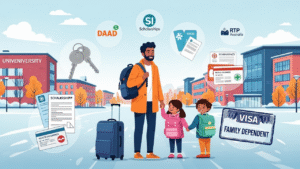Suppose your work is in an art gallery in Scandinavia. Your traveling expenses, tuition, and studio space are covered. You are working with overseas curators, and are not being sponsored by the world-famous backer that you might have been used to working on. The backer would be a cultural ministry that you have never heard of.
It is not some fantasy. It is simply uncommon—and that is the issue.
Although indeed there are government scholarships for artists, they are usually obscured, buried in the depths of Ministry of Culture websites, or mislabelled under more non-descript titles such as mobility grants or creative exchange programs. Artists fail to capitalize on most of these opportunities due to the feeling that the process is remote, overly academic, or tailored for more conventional fields.
This paper is your guide to the rare opportunities. You might be a painter in Nigeria, a poet in India, or a digital creator in Brazil—the point is simple: here, we will help you find real and fully funded government opportunities around the world, and avoid being deceived by scam companies or false advertisements.
What Are Uncommon Artist Scholarships Offered by Government?
This is simple: they are grants—usually to study, create, or collaborate in another country—and are specifically for artists, funded by national or regional governments.
They are not few in number, but because of their special character, they are often:
-
Hidden or poorly promoted beyond their home country
-
Limited to small numbers of recipients
-
Directed at non-mainstream or underrepresented cultural niches
-
Buried beneath academic or STEM-heavy scholarship listings
Such scholarships are typically offered by:
-
Ministries of Culture
-
Arts Councils
-
Cultural Diplomacy Divisions of foreign ministries
-
Foreign embassies or consulates
Eligible artists include musicians, dancers, theatre practitioners, writers, visual artists, filmmakers, performers, craft-makers, and digital media creators—with or without formal degrees.
The Case of Governments Spending on the Arts (In Secret)
As much as STEM and business studies steal scholarship headlines, the arts are still funded—often quietly—by many governments. Here’s why:
1. Cultural Diplomacy
Art helps build bridges between nations. Exporting artists abroad—or welcoming them in—is a form of diplomacy that fosters cultural tolerance and international appreciation.
2. Preserving Heritage
Many rare scholarships aim to preserve and modernize traditional art forms, especially when aligned with diaspora communities in other nations.
3. Creative Economy Investment
Governments are recognizing artists as key players in the global economy. By supporting creatives, they also promote design, media, tourism, and heritage industries.
4. Policy-Based or Treaty-Based Programs
Some opportunities arise from cross-border agreements or global partnerships—such as Nordic cultural cooperation or UNESCO-supported artist mobility frameworks.
Eligibility: Who Is Eligible?
This section varies by country and scholarship, but here are some common eligibility features found in government-funded artist programs:
Citizenship or Residency
-
Most scholarships require applicants to be citizens or permanent residents of the funding nation.
-
However, others are specifically designed for artists from developing countries or those involved in cultural partnerships or exchanges.
Track Record in Art
-
A formal degree is not always required.
-
What’s often needed is a portfolio or documentation of your creative work—such as exhibitions, performances, published works, installations, or collaborative projects.
Career Development Stage
-
Some programs target young artists (e.g., under 35 or still in school).
-
Others focus on mid-career or established artists with a recognizable body of work.
Language Skills
-
Depending on the host country, English may be sufficient.
-
However, knowledge of the local language can be a strong advantage and may improve your integration and competitiveness.
Europe: Rare Government Scholarships for Artists
Let us begin with Europe, where public funding for the arts and support for cross-cultural exchange is both historic and active.
Germany – DAAD Artists and Architects Scholarships
The well-known DAAD (German Academic Exchange Service) offers specialized tracks for artists in areas such as:
-
Fine arts, film, design, visual communication, and performing arts
-
Master’s degrees or project-based residencies in Germany at the postgraduate level
Benefits include:
-
Monthly living allowance
-
Health insurance
-
Travel expenses
-
Tuition or project fees
Applicants must submit a portfolio, project plan, and a reference letter. University admission is not required in early stages, making this ideal for self-driven creatives.
Sweden – Swedish Institute Creative Scholarships
The Swedish Institute offers creative scholarships as part of broader regional programs, including:
-
The Baltic Sea region interchange of artists
-
Africa cultural mobility and creative industry initiatives
Target fields include:
-
Theatre
-
Visual storytelling
-
Multimedia and digital arts
-
Music composition
Support includes:
-
Tuition-free education
-
Living stipend
-
Integration into creative clusters in Stockholm, Malmö, and Gothenburg
These are program-specific, international-friendly, and emphasize cultural cooperation and measurable impact.
Finland – Taike Mobility Grants & Cultural Foundation Support
Funded by the Ministry of Education and Culture and the Arts Promotion Centre Finland (Taike), these programs support:
-
Short-term artist residencies
-
Multinational research collaborations
-
Study or research visits at Finnish arts institutions
Grants are available to:
-
Finnish artists going abroad
-
International artists coming to Finland under cultural cooperation agreements
Applications are typically in English and evaluated based on originality, cultural engagement, and public relevance.
France – Cité Internationale des Arts & Ministry Fellowships
The Ministry of Culture in France supports artists through:
-
Residencies at Cité Internationale des Arts in Paris
-
Support from the CNC (Centre National du Cinéma) for filmmakers
-
Regional councils for performing and visual artists
Fellowship features may include:
-
Residential space in Paris or other cities
-
Studio access
-
Monthly cultural programming and support
Programs often focus on themes like:
-
Urban space
-
Ecology
-
Intercultural dialogue
-
Digital experimentation
Asian Rare Government Scholarships
Now we shift to the East, where ministries are blending tradition and futurism to create new global cultural voices. The following Asian governments quietly fund art-centered scholarships and exchanges for international creatives:
South Korea – Korean Government Scholarship Program (Arts G)
There is an arts stream within the prestigious Global Korea Scholarship (GKS), which covers degrees in:
-
Korean music and dances
-
Korean painting
-
Modern arts (visual and performing)
These are offered through dedicated arts universities in Korea, and the scholarship includes:
-
Full tuition
-
Monthly living expenses
-
Airfare and housing settlement allowance
Priority is given to students from developing countries. No prior Korean language skills are required, as the program begins with a 1-year intensive language course.
Taiwan – Ministry of Culture International Exchange Grants
The Taiwan Ministry of Culture sponsors international artists through:
-
Short-term residencies
-
Collaborative art productions with local partners
-
Transborder exhibitions and performances
Key themes include:
-
Asia-Pacific cultural cooperation
-
Heritage and indigenous arts
-
Digital storytelling
-
Aboriginal expression and preservation
Artists may apply individually or through partner institutions.
India – ICCR Scholarships for Foreign Artists
The Indian Council for Cultural Relations (ICCR) offers scholarships for international artists to study traditional Indian arts, including:
-
Classical Indian music
-
Dance
-
Painting
-
Sculpture
Features of this program:
-
Offered through accredited government art colleges
-
Open to applicants from Africa, Southeast Asia, the Middle East, and Latin America
-
Covers lodging, room and board, and living stipends
-
Requires a portfolio and a basic plan of study
Rare Government Scholarships by Region: North America
Even in North America, where private and institutional funding is dominant, rare government-supported art scholarships and grants still exist.
Canada – Canada Council for the Arts (International Grants)
Canada quietly supports international artist mobility through its national arts council. While most grants are for Canadian citizens, there are programs that allow non-Canadians to participate through:
-
Reciprocal exchanges
-
Cross-border co-productions
-
Creative residencies in partnership with Canadian institutions
These programs cover:
-
Project and travel expenses
-
Exhibition costs
-
Collaborative art grants (e.g., Indigenous, Francophone, or community-based initiatives)
Notably, the Canada Council prioritizes:
-
Cultural equity
-
Marginalized voices
-
Global collaboration, rather than traditional academic merit
United States Fulbright Creative Performing Arts Awards
A little known branch of the Fulbright U.S. Student Program is that of the creative and performing arts. They are given to visual artists, choreographers, composers, playwrights, filmmakers, writers and many others.
Candidates suggest a project that is self-led in a recipient nation in which:
-
Monthly stipend
-
Airfare
-
Health coverage
-
The availability of academic or artistic institution (it is not always necessary)
You need to indulge in cultural connection and creative inquiry and not just technical proficiency in your work.
Latin America Rare Government Scholarships
Brazil – Artes sem Fronteiras (Arts Without Borders)
This program is funded by Brazil Ministry of Culture and it supports:
-
Stay in a foreign country to be an artist in residence
-
Cross-border workshops
-
Caretaken exhibitions or performances
It promotes communication between Brazil and other parts such as Africa, Latin America, and Europe. Usually, these are project-related and are open to Brazilians who work abroad as well as foreign musicians who work with Brazilian institutions.
Chile – DIRAC Cultural Grants
DIRAC is the instrument to finance international artistic programming financed by the Ministry of Foreign Affairs of Chile:
-
Travels with Chilean artists to other parts of the world
-
Sometimes it finances the foreign artists who collaborate with Chilean establishments
-
Promotes co-productions, translation of books, artist exchanges
The calls DIRAC publishes annually are publicly accessible and they set artistic ambitions that relate to areas such as climate, inclusion, and democracy as far as foreign policy concerns.
Colombia – The Ministry of Culture Research Grants
The cultural ministry of Colombia provides financial support in artistic research:
-
Performance fieldwork or visual or design fieldwork
-
Preservation of the arts of indigenous and Afro-descendants
-
Local storytelling and creative writing projects
Most grants are reserved to Colombian artists, however, foreign partners can be considered by joining national arts collectives or academic programs.
Middle East Rare Government Scholarships
United Arab Emirates – Abu Dhabi Department of Culture and Tourism Grants
Under the programs such as:
-
The Cultural Foundation
-
Warehouse421 Residency Program
-
State sponsored events (such as Sharjah Biennial)
Foreign artists have an opportunity to apply for:
-
Project grants
-
Short-term and long residencies
-
Publishing and film aid
Topics of programs tend to center on ideas of identity, urban history, migration and experimental art.
Qatar – Doha Film Institute (DFI) Grants
The DFIs of Qatar finance film directors under a worldwide policy concerning special interest in:
-
Emerging voices
-
Representation of the region (MENA and global south)
-
Women and novice directors
Some of the factors are not confined to Qataris but focus is on robust creative solutions, artistic and cultural value, as well as a rich cultural storyline.
Saudi Arabia – Ministry of Culture Scholarship Program
The participants are entitled to international scholarships in the country of Saudi Arabia:
-
Performing Art
-
Culinary Arts
-
Film and Media
-
Museum Studies and Archaeology
Although they do not contribute directly to foreigners, they contribute to institutional partnerships which open new avenues of joint programs and exhibitions.
The Application Process of Rare Artist Scholarships
It is the most important part. You have seen the scholarships, now the time to apply. This is a down-to-earth step-by-step plan which will work whether you are headed to Berlin or Buenos Aires.
Step 1: Go Beyond the Common Platforms
Most of the rare grants cannot be discovered through the major scholarship search engines. Instead:
-
Visit ministry of culture websites
-
Find pages of embassies or consulates of your area
-
Visit websites such as On the Move, ResArtis, and TransArtists
-
Follow NGOs and local arts councils on social media
Search using such wording as:
-
Artist mobility grant
-
Implementation and grant funds providing support and mobility to artists
-
Representatives
-
A collaborative project between the national section (Women in Design, Young Designers) and the federal field of activity (Culture). AA/C
-
Federal housing visual artists program
-
Cultural diplomacy art scholarship + [country]
United States Fulbright Creative Performing Arts Awards
A little known branch of the Fulbright U.S. Student Program is that of the creative and performing arts. They are given to visual artists, choreographers, composers, playwrights, filmmakers, writers and many others.
Candidates suggest a project that is self-led in a recipient nation in which:
-
Monthly stipend
-
Airfare
-
Health coverage
-
The availability of academic or artistic institution (it is not always necessary)
You need to indulge in cultural connection and creative inquiry and not just technical proficiency in your work.
Latin America Rare Government Scholarships
Brazil – Artes sem Fronteiras (Arts Without Borders)
This program is funded by Brazil Ministry of Culture and it supports:
-
Stay in a foreign country to be an artist in residence
-
Cross-border workshops
-
Caretaken exhibitions or performances
It promotes communication between Brazil and other parts such as Africa, Latin America, and Europe. Usually, these are project-related and are open to Brazilians who work abroad as well as foreign musicians who work with Brazilian institutions.
Chile – DIRAC Cultural Grants
DIRAC is the instrument to finance international artistic programming financed by the Ministry of Foreign Affairs of Chile:
-
Travels with Chilean artists to other parts of the world
-
Sometimes it finances the foreign artists who collaborate with Chilean establishments
-
Promotes co-productions, translation of books, artist exchanges
The calls DIRAC publishes annually are publicly accessible and they set artistic ambitions that relate to areas such as climate, inclusion, and democracy as far as foreign policy concerns.
Colombia – The Ministry of Culture Research Grants
The cultural ministry of Colombia provides financial support in artistic research:
-
Performance fieldwork or visual or design fieldwork
-
Preservation of the arts of indigenous and Afro-descendants
-
Local storytelling and creative writing projects
Most grants are reserved to Colombian artists, however, foreign partners can be considered by joining national arts collectives or academic programs.
Middle East Rare Government Scholarships
United Arab Emirates – Abu Dhabi Department of Culture and Tourism Grants
Under the programs such as:
-
The Cultural Foundation
-
Warehouse421 Residency Program
-
State sponsored events (such as Sharjah Biennial)
Foreign artists have an opportunity to apply for:
-
Project grants
-
Short-term and long residencies
-
Publishing and film aid
Topics of programs tend to center on ideas of identity, urban history, migration and experimental art.
Qatar – Doha Film Institute (DFI) Grants
The DFIs of Qatar finance film directors under a worldwide policy concerning special interest in:
-
Emerging voices
-
Representation of the region (MENA and global south)
-
Women and novice directors
Some of the factors are not confined to Qataris but focus is on robust creative solutions, artistic and cultural value, as well as a rich cultural storyline.
Saudi Arabia – Ministry of Culture Scholarship Program
The participants are entitled to international scholarships in the country of Saudi Arabia:
-
Performing Art
-
Culinary Arts
-
Film and Media
-
Museum Studies and Archaeology
Although they do not contribute directly to foreigners, they contribute to institutional partnerships which open new avenues of joint programs and exhibitions.
The Application Process of Rare Artist Scholarships
It is the most important part. You have seen the scholarships, now the time to apply. This is a down-to-earth step-by-step plan which will work whether you are headed to Berlin or Buenos Aires.
Step 1: Go Beyond the Common Platforms
Most of the rare grants cannot be discovered through the major scholarship search engines. Instead:
-
Visit ministry of culture websites
-
Find pages of embassies or consulates of your area
-
Visit websites such as On the Move, ResArtis, and TransArtists
-
Follow NGOs and local arts councils on social media
Search using such wording as:
-
Artist mobility grant
-
Implementation and grant funds providing support and mobility to artists
-
Representatives
-
A collaborative project between the national section (Women in Design, Young Designers) and the federal field of activity (Culture). AA/C
-
Federal housing visual artists program
-
Cultural diplomacy art scholarship + [country]
Step 2: Develop a Concentrated Portfolio
Style, themes and impact need to be clear in your portfolio.
Include:
-
5–10 samples of good quality
-
Brief context or project summaries
-
Press coverage, review, or testimonies
-
A short biography and resume about the artist
Hint: You do not need to have a gallery to show portfolios. No need to do that—just will, direction, and personal statements.
Step 3: Write a Purpose-Driven Statement
It is in your statement or proposal that you answer:
-
What do I wish to make out of this opportunity?
-
What is the interest of that?
-
Who is going to help me? Who is going to gain except myself?
-
What are the results that I want to share?
Turn it into something other than a career winner. Governments invest in culture because it is diplomatic, heritage, and because it is good to the society—abide by that.
Step 4: Timeline Tracking
Most artist grants are seasonal with deadlines in them.
Do:
-
Schedule Google Calendar reminders
-
Sign up to newsletters
-
Turn to former recipients to ask them tips
-
Make applications prior to the course deadlines and anticipate months to weeks to get the awards decisions made
What You Can Expect Once You Are Chosen
The scholarship is a rare one—you have gotten it. Now what?
1. Logistics in Travelling and Housing
Governments are usually supportive of:
-
Airfare or compensation
-
Residencies accommodation (where there are)
-
Visas (enabled by diplomatic liaison with the consulate)
2. Cultural Orientation
Expect:
-
Language assistance
-
Local artistic networks introduction
-
Collaboration with other foreign artists
-
Invitation to conferences or open panels
3. Artistic Responsibility
The receivers are usually supposed to:
-
Design an external product (exhibition, performance, talk)
-
Partner with local institutions
-
Provide program afterthoughts or images
It is not a retreat. It is a cultural dialogue.
Top Errors to Avoid
-
Propositioning of thematically generic proposals without artistic voice
-
Neglect of the theme of the grant or its cultural orientation
-
Failure to meet deadlines because of poor planning
-
Cramming your portfolio with numbers rather than with meaning
Final Thoughts
Expression, connection, and truth is something that has always been associated with art. Nowadays, though, it is also about access—but access is about funding.
Creators are being supported behind the scenes by their governments. They do not just finance your plane ticket, your studio space, your tuition, your vision because they feel they have to, but they believe in the power of what your work can change the world to be.
Do not wait to be found by someone. Find out about it on your own, and apply.
The next step in your career as an artist can be a grant you did not want to seek.







